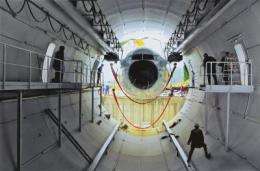The new sky

Less noise, less exhaust, less refuse -- air travel of the future is expected to be quieter, cleaner and more environmentally friendly. To achieve this goal, new structural concepts and aerodynamic profiles have to be engineered, along with better drive concepts as well as adapted logistical designs, and then put to use. In the EU project Clean Sky, Fraunhofer researchers want to make their contribution to solving this Herculean task.
They present their initial findings at ILA, the international aerospace trade show in Berlin, from June 8 to 13, 2010.
Flying can become considerably more environmentally friendly - the aviation experts from the "Advisory Council for Aeronautics Research in Europe" ACARE are certain of this. In the guidelines that they compiled for the European aviation industry, the experts are calling for a 50 percent reduction in carbon dioxide and noise emissions by 2020; nitrogen oxide output should be reduced by 80 percent.
The goals are ambitious, Professor Holger Hanselka thinks - but achievable. Since 2008, the head of the Fraunhofer Institute for Structural Durability and System Reliability LBF in Darmstadt has been a member of the Governing Board, the decision-making body of the EU's "Clean Sky" project, one of the most expansive and complex research projects in Europe, with a subsidy volume of 1.6 billion euro. The goal of the 86 participating industry and research partners from 16 nations is not only to develop unique technologies for specific applications, but also to evaluate and advance the entire aeronautics system.
In its first stages a task force set the plot for the technology fields for the airplane encompassing engines, wings and fuselage structures as well as systems and landing gear, etc.. Each of these components can be put into an improved ecological balance of the system as a whole. An optimized airflow profile on the wings cuts noise and saves energy; improved engine technology minimizes kerosene consumption; materials with long lifespans save on raw materials; the application of recyclable materials prevents the accumulation of waste. The breadth of detail is immense: Materials have to be tested, material flows simulated, calculation methods refined, experiments conducted and analyzed. "At every level of the undertaking, goals must be precisely defined, so that everyone knows exactly what he or she has to do," explains John Simpson, Fraunhofer program manager and steering member.
For the first time, the researchers also intend to take into account the lifecycle of materials within airline construction; until now, aircraft headed for retirement were extremely difficult to scrap and dispose of. Specialists at the Fraunhofer Institute for Chemical Technology ICT, for example, developed special plastics that not only possess the exact material characteristics desired by the manufacturer, but can also be disposed of at the end of their economic lives in an environmentally sound manner. "Airplane manufacturers who had hitherto built their aircraft primarily at manufacturing plants want to automate their production in the future. Fraunhofer institutes that specialize in production processes can bring their experiences into the equation," explains Hanselka. Therefore, researchers at the Fraunhofer Institute for Manufacturing Engineering and Applied Materials Research IFAM are investigating the best way of joining the most important lightweight construction materials in use today, and how new paint systems can reduce frictional resistance.
The aviation industry places a particularly premium on safety - for good reason, because the lives of passengers and crew depend on the integrity of the materials used being able to withstand mercurial pressure and temperature conditions as well as the vibrations and shearing forces that occur over the course of each flight. At ILA, the LBF experts will display a new sensor system for online monitoring of airfoil wings: Actuators that are integrated into the wings emit impulses. A network of sensors receives the signals and transmits them to an electronic data processing system. Changes in the transfer pathway that indicate tears in the material can be immediately detected in this manner. The researchers at the Fraunhofer Institute for Electronic Nano Systems ENAS are currently engineering a demonstrator that can measure deformations as they occur when an airplane takes off or lands.
Right after safety come health and passenger well-being. So, for example, testing should indicate if a newly developed material diminishes the air quality in the passenger cabin. In the Flight Test Facility at the Fraunhofer Institute for Building Physics IBP, researchers can simulate the pressure, temperature and moisture conditions during a flight.
Provided by Fraunhofer-Gesellschaft

















